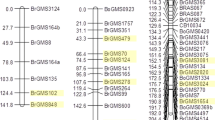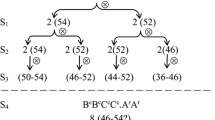Abstract
We trialled a two-step method of producing allohexaploid Brassica with three genomes (A, B, and C) derived from pair-wise crossing among three allotetraploid Brassica species. In the first step, the three allotetraploid Brassica species (Brassica juncea, AjAjBjBj; Brassica napus, AnAnCnCn; and Brassica carinata, BcBcCcCc) were intercrossed in pairs to produce unbalanced trigenomic hybrids: AjAnBjCn, BjBcAjCc and CnCcAnBc. In the second step, these hybrids were crossed with the complementary allotetraploid parent, that is, AjAnBjCn × BcBcCcCc (B. carinata), BjBcAjCc × AnAnCnCn (B. napus) and CnCcAnBc × AjAjBjBj (B. juncea). We hypothesised that the unbalanced trigenomic hybrids would produce high levels of unreduced gametes with the same genome composition as the hybrid. These unreduced gametes would unite with reduced gametes from the complementary allotetraploids to form allohexaploid Brassica progeny (AjAnBcBjCcCn). From 112 s generation interspecific progeny, two progeny were shown by locus-specific simple sequence repeat markers to be near-allohexaploids derived from an unreduced gamete from CnCcAnBc and a reduced gamete from B. juncea (AjBj). One of these plants was highly self-fertile, had 50 chromosomes, and inherited patterns of marker alleles (AjAnBcBjCcCn) that were predicted from first division restitution at meiosis in the CnCcAnBc parent. The second near-allohexaploid had 60 chromosomes, was sterile, and inherited patterns of marker alleles that indicated second division restitution in the CnCcAnBc parent. Trigenomic hybrid Brassica produced by these methods will be valuable bridges to move alleles between allotetraploid species, and may contribute useful meiotic stability alleles to a future allohexaploid species.



Similar content being viewed by others
References
Bretagnolle F, Thompson JD (1995) Tansley review No. 78. Gametes with the stomatic (sic) chromosome number: mechanisms of their formation and role in the evolution of autopolypoid plants. New Phytol 129:1–22
Chen S, Nelson MN, Chèvre AM, Jenczewski E, Li Z, Mason AS, Meng J, Plummer JA, Pradhan A, Siddique KHM, Snowdon RJ, Yan G, Zhou W, Cowling WA (2011) Trigenomic bridges for Brassica improvement. Crit Rev Plant Sci (in press)
Cousin A, Nelson M (2009) Twinned microspore-derived embryos of canola (Brassica napus L.) are genetically identical. Plant Cell Rep 28:831–835
Cousin A, Heel K, Cowling WA, Nelson MN (2009) An efficient high-throughput flow cytometric method for estimating DNA ploidy level in plants. Cytom Part A 75:1015–1019
d’Erfurth I, Jolivet S, Froger N, Catrice O, Novatchkova M, Simon M, Jenczewski E, Mercier R (2008) Mutations in AtPS1 (Arabidopsis thaliana Parallel Spindle 1) lead to the production of diploid pollen grains. PLoS Genet 4:e1000274
Eenink AH (1975) Matromorphy in Brassica oleracea L. VII. Research on products of microsporogenesis and gametogenesis from prickle pollinated plants. Euphytica 24:45–52
FitzJohn RG, Armstrong TT, Newstrom-Lloyd LE, Wilton AD, Cochrane M (2007) Hybridisation within Brassica and allied genera: evaluation of potential for transgene escape. Euphytica 158:209–230
Fukushima E (1930) Formation of diploid and tetraploid gametes in Brassica. Jpn J Bot 5:273–284
Heslop-Harrison JS, Heslop-Harrison Y, Shivanna KR (1984) The evaluation of pollen quality, and a further appraisal of the fluorochromatic (FCR) test procedure. Theor Appl Genet 67:367–375
Heyn FJ (1977) Analysis of unreduced gametes in the Brassiceae by crosses between species and ploidy levels. Zeitschrift für Pflanzenzüchtung 78:13–30
Howard HW (1942) The effect of polyploidy and hybridity on seed size in crosses between Brassica chinensis, B. carinata, amphidiploid B. chinensis-carinata and autotetraploid B. chinensis. J Genet 43:105–119
Iwasa S (1964) Cytogenetic studies on the artificially raised trigenomic hexaploid hybrid forms in the genus Brassica. J Fac Agricu Kyushu Univers 13:309–352
Jenczewski E, Eber F, Grimaud A, Huet S, Lucas MO, Monod H, Chèvre AM (2003) PrBn, a major gene controlling homeologous pairing in oilseed rape (Brassica napus) haploids. Genetics 164:645–653
Jiang Y, Tian E, Li R, Chen L, Meng JL (2007) Genetic diversity of Brassica carinata with emphasis on the interspecific crossability with B. rapa. Plant Breed 126:487–491
Li M, Qian W, Meng J, Li Z (2004) Construction of novel Brassica napus genotypes through chromosomal substitution and elimination using interploid species hybridization. Chromosom Res 12:417–426
Li M, Chen X, Meng J (2006) Intersubgenomic heterosis in rapeseed production with a partial new-typed Brassica napus containing subgenome Ar from B. rapa and Cc from Brassica carinata. Crop Sci 46:234–242
Mackay GR, Low RJ (1975) Spontaneous triploids in forage kale, Brassica oleracea var. acephala. Euphytica 24:525–529
Mason AS, Huteau V, Eber F, Coriton O, Yan G, Nelson MN, Cowling WA, Chèvre A-M (2010) Genome structure affects the rate of autosyndesis and allosyndesis in AABC, BBAC and CCAB Brassica interspecific hybrids. Chromosom Res 18:655–666
Mason AS, Nelson MN, Castello M-C, Yan G, Cowling WA (2011) Genotypic effects on the frequency of homoeologous and homologous recombination in Brassica napus × B. carinata hybrids. Theor Appl Genet 122:543–553
Meng J, Shi S, Gan L, Li Z, Qu X (1998) The production of yellow-seeded Brassica napus (AACC) through crossing interspecific hybrids of B. campestris (AA) and B. carinata (BBCC) with B. napus. Euphytica 103:329–333
Morinaga T (1929) Interspecific hybridisation in Brassica II. The cytology of F1 hybrids of B. cernua and various other species with 10 chromosomes. Jpn J Bot 4:277–289
Morinaga T (1934) Interspecific hybridisation in Brassica VI. The cytology of F1 hybrids of B. juncea and B. nigra. Cytologia 6:62–67
Moyes CL, Lilley JM, Casais CA, Cole SG, Haeger PD, Dale PJ (2002) Barriers to gene flow from oilseed rape (Brassica napus) into populations of Sinapis arvensis. Mol Ecol 11:103–112
Murphy DJ (2007) People plants and genes. Oxford University Press, Oxford
Nelson MN, Mason AS, Castello M-C, Thomson L, Yan G, Cowling WA (2009) Microspore culture preferentially selects unreduced (2n) gametes from an interspecific hybrid of Brassica napus L. × Brassica carinata Braun. Theor Appl Genet 119:497–505
Pradhan A, Plummer JA, Nelson MN, Cowling WA, Yan G (2010a) Successful induction of trigenomic hexaploid Brassica from a triploid hybrid of B. napus L. and B. nigra (L.) Koch. Euphytica 176:87–98
Pradhan A, Plummer JA, Nelson MN, Cowling WA, Yan G (2010b) Trigenomic hybrids from interspecific crosses between Brassica napus and B. nigra. Crop Pasture Sci 61:464–474
Prakash S, Takahata Y, Kirti PB, Chopra VL (1999) Cytogenetics. In: Gómez-Campo C (ed) Developments in plant genetics and breeding 4: biology of Brassica coenospecies. Elsevier, Amsterdam, pp 59–90
Qian W, Chen X, Fu D, Zou J, Meng J (2005) Intersubgenomic heterosis in seed yield potential observed in a new type of Brassica napus introgressed with partial Brassica rapa genome. Theor Appl Genet 110:1187–1194
Rahman MH (2001) Production of yellow-seeded Brassica napus through interspecific crosses. Plant Breed 120:463–472
Ramsey J, Schemske DW (1998) Pathways, mechanisms, and rates of polyploid formation in flowering plants. Annu Rev Ecol Syst 29:467–501
Sheidai M, Noormohamandi Z, Sotodeh M (2006) Cytogenetic variability in several canola (Brassica napus) cultivars. Caryologia 59:267–276
Snowdon R, Köhler W, Köhler A (1997) Chromosomal localization and characterization of rDNA loci in the Brassica A and C genomes. Genome 40:582–587
Tian E, Jiang Y, Chen L, Zou J, Liu F, Meng J (2010) Synthesis of a Brassica trigenomic allohexaploid (B. carinata x B. rapa) de novo and its stability in subsequent generations. Theor Appl Genet 121:1431–1440
Tokumasu S (1965) On the origin of the matromorphic plants of Brassica japonica obtained from the cross between Brassica and Raphanus. J Jpn Soc Hortic Sci 34:79–88
U N (1935) Genome-analysis in Brassica with special reference to the experimental formation of B. napus and peculiar mode of fertilization. Jpn J Bot 7:389–452
Verma SC, Rees H (1974) Nuclear DNA and the evolution of allotetraploid Brassicae. Heredity 33:61–68
Wang J, Lydiate DJ, Parkin AP, Falentin C, Delourme R, Carion PWC, King GJ (2011) Integration of linkage maps for the amphidiploid Brassica napus and comparative mapping with Arabidopsis and Brassica rapa. BMC Genomics 12:101
Acknowledgments
This work was supported by the Australian Research Council Linkage Project LP0667805, with industry partners Council of Grain Grower Organisations Ltd and Norddeutsche Pflanzenzucht Hans-Georg Lembke KG. We thank Canola Breeders Western Australia Pty Ltd for provision of the cultivars and accessions used in this study. MNN and WAC were supported by Grains Research and Development Corporation project UWA00120 during this project. We also thank Junko Takahira and Clare O’Lone for collection of molecular marker data for individuals N1C1.J1-1 and N1C1.J1-2.
Author information
Authors and Affiliations
Corresponding author
Electronic supplementary material
Below is the link to the electronic supplementary material.
Rights and permissions
About this article
Cite this article
Mason, A.S., Yan, G., Cowling, W.A. et al. A new method for producing allohexaploid Brassica through unreduced gametes. Euphytica 186, 277–287 (2012). https://doi.org/10.1007/s10681-011-0537-4
Received:
Accepted:
Published:
Issue Date:
DOI: https://doi.org/10.1007/s10681-011-0537-4




